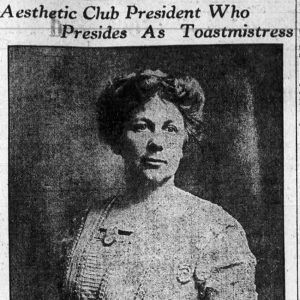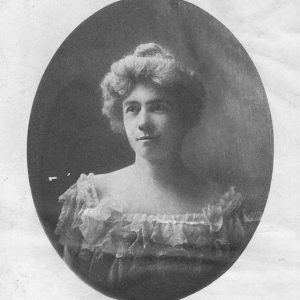calsfoundation@cals.org
Aesthetic Club
The Aesthetic Club is one of the oldest women’s clubs west of the Mississippi River. It began when a group of young women wishing to start a reading club organized on January 16, 1883, in Little Rock (Pulaski County). Aesthetic Club founders Cynthia Polk, Sallie Martin, Ida Martin, Fannie Jabine, Jane Georgine Woodruff, Mary Knapp, Gertrude Hempstead, Harriet Jabine, and Virginia Hamilton immediately expanded their objectives “to present programs of a literary, artistic, musical, and timely trend” in order to “assist in educational uplift, and to bring its members together for social enjoyment.”
The name, proposed by Knapp, was borrowed from the Aesthetic Movement, which was “emulous of cultivating ‘the beautiful’ in all things.” Inspired by Oscar Wilde’s comments on art and beauty (“Aesthetics…are the science of the beautiful”), the club adopted Wilde’s favorite flower, the Easter lily, as its club flower. The club motto is from Lewis Carroll’s poem, “Poeta Fit, Non Nascitur,” published in 1869. The motto, “The Good, the True, the Beautiful,” has continued on the cover of the club’s yearbooks.
In 1885, the members implemented their first by-laws, limiting membership to fifty. The club was still meeting in members’ homes. By 1894, the membership limit had increased to 100, and a new meeting place became necessary. Members of the Columbian Commission, the women’s club that had furnished the Arkansas Building at the Columbian Exposition World’s Fair in Chicago, Illinois, in 1893, invited the Aesthetic Club to use the Columbian Art Memorial Room as its meeting place. The Columbian Commission was using the old Little Rock Arsenal, now part of Little Rock’s MacArthur Park. The Aesthetic Club agreed, and by January 30, 1917, the Columbian Commission had decided to turn over all its furnishings, which had belonged to the Columbian Exposition, and funds to the Aesthetic Club.
In 1893, the Aesthetic Club joined the national General Federation of Women’s Clubs and in 1896, joined the Arkansas Federation of Women’s Clubs. Programs from this period often reflected the interests of the larger women’s clubs. The Aesthetic Club worked with the Arkansas Federation to secure library legislation in 1902. On March 11, 1913, the program papers were “Women’s Part in Social Progress” and “Are You a Suffragette—If Not, Why Not?” But on April 12, 1927, the club resigned from the Arkansas Federation of Women’s Clubs, stating that their own objectives did not include the civic work of the federation.
The Aesthetic Club’s objective is “to present programs at various meetings of a literary, artistic, musical, and timely trend; to assist in educational uplift; and to bring its members together for social enjoyment.” A member of the Aesthetic Club may read a paper, play a musical instrument, sing, or be appointed chairman of the day and be responsible for introducing speakers and musicians or greeting members. Membership of the Aesthetic Club is still limited so that its active members total no more than 100, not including inactive and associate members.
An active member is required to attend more than half the meetings and participate in the programs. Programs educate and entertain, such as the program on March 8, 2005. Two papers were presented: first, “Conflicting Concepts of Jefferson and Hamilton” by Martha Sowell, an analysis of economic thought and predictions, followed by “Warring Words of Frost and Sandburg” by Dale Ronnel, which profiled poets Robert Frost and Carl Sandburg and their works. The program interlude between presentations was a musical presentation by Debbie Cross and Georganne Ricks, which included “The Nursemaid’s Lament” from Gilbert and Sullivan’s The Pirates of Penzance.
Amelia Smith, an active Aesthetic Club member between 1940 and 1960, summed up the club’s strength: “It has always been a body of women who stood for and lived up to its motto, ‘The Good, the True, and the Beautiful.’ Never once, whether there were good times, wars, a Great Depression, or social changes, has it departed from remarkable standards.”
For additional information:
Aesthetic Club History Committee. Aesthetic Club Centennial History 1883–1983. Little Rock: Rose Publishing Company, 1983.
Aesthetic Club Papers. Arkansas State Archives, Little Rock, Arkansas.
Eison, James Reed. “The Hostile Years: The Museum–Aesthetic Club Controversy, 1951–1954.” Pulaski County Historical Review 39 (Summer 1991): 37–46.
Powell, Sloan. “Pilgrims Journeying to the Shrine of Knowledge and Sociability: The Aesthetic Club in Little Rock, Arkansas, 1883–1900.” Pulaski County Historical Quarterly 46 (Summer 1998): 26–41.
Paula Kyzer Taylor
Arkansas History Commission
 Mrs. L. E. Gardner
Mrs. L. E. Gardner  Frances Hanger
Frances Hanger 



Comments
No comments on this entry yet.